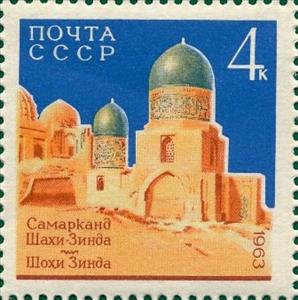Stamp: Shakhi-Zinda mosque (XIV-XVII c.) (Soviet Union, USSR 1963)
Shakhi-Zinda mosque (XIV-XVII c.) (Soviet Union, USSR 1963)
14 November (Soviet Union, USSR ) within release Ancient Architecture of Samarkand goes into circulation Stamp Shakhi-Zinda mosque (XIV-XVII c.) face value 4 Russian kopek
| Stamp Shakhi-Zinda mosque (XIV-XVII c.) in catalogues | |
|---|---|
| Michel: | Mi:SU 2825 |
Stamp is square format.
Designer: V. Pimenov. Paper: ordinary.Also in the issue Ancient Architecture of Samarkand:
- Stamp - Gur-Emir mausoleum (XV c.) face value 4;
- Stamp - Shakhi-Zinda mosque (XIV-XVII c.) face value 4;
- Stamp - Ancient Architecture of Samarkand face value 6;
- Stamp - Registan Square - Monumental Architecture (XV-XVII c.) face value 6;
Stamp Shakhi-Zinda mosque (XIV-XVII c.) it reflects the thematic directions:
Mosquitoes, the Culicidae, are a family of small flies consisting of 3,600 species. The word mosquito (formed by mosca and diminutive -ito) is Spanish and Portuguese for little fly. Mosquitoes have a slender segmented body, one pair of wings, three pairs of long hair-like legs, and specialized, highly elongated, piercing-sucking mouthparts. All mosquitoes drink nectar from flowers; females of some species have in addition adapted to drink blood. The group diversified during the Cretaceous period. Evolutionary biologists view mosquitoes as micropredators, small animals that parasitise larger ones by drinking their blood without immediately killing them. Medical parasitologists view mosquitoes instead as vectors of disease, carrying protozoan parasites or bacterial or viral pathogens from one host to another.
